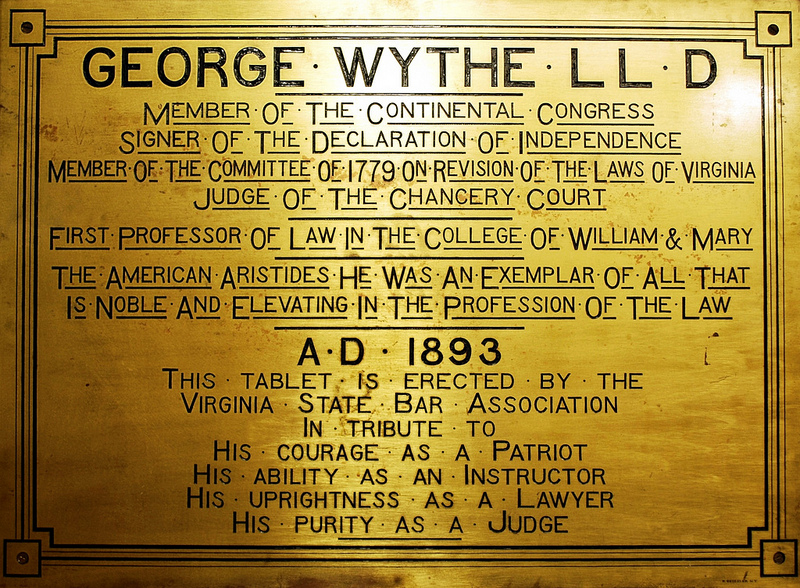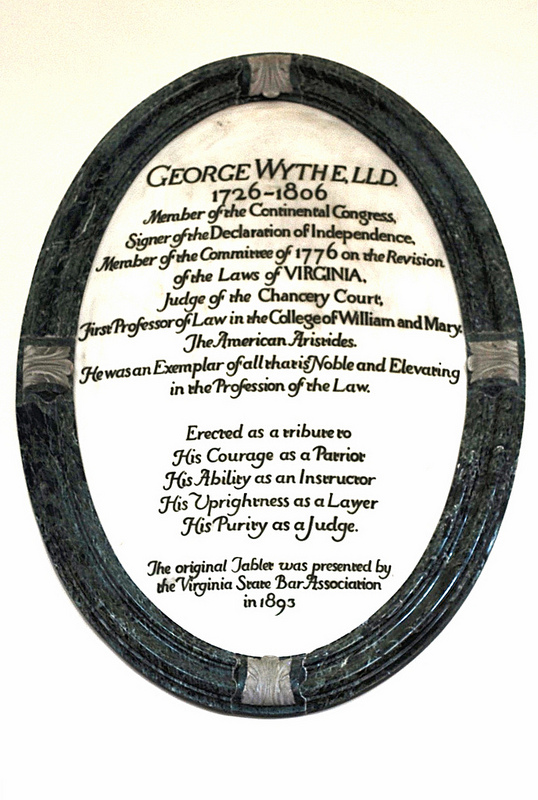Wythe Tablet
Contents
Reports of the Virginia State Bar Association
1891
On July 30, 1891, at the third day of the third annual meeting of the Virginia State Bar Association, member W. W. Henry of Richmond offered the following resolution:
Whereas the grave of Chancellor George Wythe, in the churchyard of St. John's church, Richmond, Va., is unmarked,The resolution was adopted, and the President named three men to make up the committee: W. W. Henry; R. G. H. Kean, of Lynchburg; and R. M. Hughes, of Norfolk.
Resolved, That the President of this Association appoint a committee of three, who shall ascertain as nearly as possible the locality of the said grave and report to this body at its next session, and at the same time report what will be the cost of a suitable one to be placed at or near said grave.[1]
1892
At the 1892 meeting, on July 12, Kean submitted a "Report of the Special Committee to Erect a Tablet to the Memory of Chancellor Wythe." In their attempt to ascertain the location of Wythe's grave, Kean cited relevant passages from "The Two Parsons" by George Wythe Munford[2], and from the newspaper account of Wythe's funeral in the Richmond Enquirer. The committee concluded:
The language of the order of the Council, and the terms employed in this cotemporaneous notice of the funeral procession, appear to be quite conclusive of the fact that the interment was, as Colonel Munford states, in the church-yard of St. John's, Richmond.
The other is the room of the new City Hall in Richmond, which is to be set aside for its Chancery Court. We can imagine no greater incentive for the Bar of the present day than to have constantly under their eyes such memorials to the great jurists of the past.[3]
Quite extensive inquiry among old citizens of Richmond, who take an interest in matters of this nature, corroborates the conclusion of Colonel Munford, that the grave was on the west side of the church building and not far from the wall.
The precise spot could not now be ascertained, except, possibly, by exploration with the spade. But your committee is of opinion that if such a memorial stone, as seems contemplated by the resolution, were erected on that side of the church, and near the wall, it would be sufficiently near the place of interment to answer the purpose.
The committee, however, is much impressed with the ephemeral character of monuments exposed to the elements. For this reason, and the yet more controlling one, that a memorial such as this Association would be willing to erect, would cost several hundred dollars at the least, they are forced to abandon the idea of a monument at his grave, even if the grave could be exactly located.
But the committee is not willing to recommend that the Association relinquish the purpose of erecting a memento to such a man as Chancellor Wythe.
On consideration, they are of opinion that a mural tablet might be erected which would serve to hold him out to the profession as a great exemplar. Such tablets are not expensive, and, being protected, are practically unlimited in their durability.
The committee would recommend its erection in St. John's church but for the fact that this church is a wooden structure, which places it out of the question. Two other places suggest themselves as equally appropriate. One is the chapel of the College of William and Mary, at Williamsburg, of which institution he was an alumnus. He was long a resident of Williamsburg, and many of his greatest cotemporaries now sleep beneath that chapel.
After some debate, an amendment to the resolution was carried to allow 'the location of the mural tablet be left to the discretion of the committee,'[4] and was adopted as:
Resolved, That a committee of three be appointed by the President. whose duty it shall be to procure the assent and concurrence of the proper authorities, and cause to be erected, either in the court-room of the Chancery Court for the city of Richmond, in the new court-room to be erected in the city of Richmond for the Court of Appeals, or in the chapel of William and Mary College, a mural tablet, with a suitable inscription, to the memory of Chancellor George Wythe, at a cost not to exceed the sum of two hundred dollars; which sum shall be disbursed for said purpose by the Treasurer, upon the order of the chairman of said committee.
1893
On the August 1, 1893 meeting of the State Bar Association, Kean read a final report from the committee regarding the installation of the tablet in the Wren Chapel:
After much consideration, the committee decided that the most appropriate place for the erection of this memorial was the chapel of the College of William and Mary. There were special reasons which, in the judgment of the committee, rendered this a peculiarly fitting place. Either of the other places would have emphasized simply his judicial career. But if the committee understood the sentiment of the association aright, it was not simply George Wythe the jurist, but George Wythe the lawyer, who was to be honored. In addition, this chapel commemorates his services as a legal instructor, which were a prominent portion of the work of his life. While a practitioner of law, he was the teacher of Jefferson, and in 1780, when the College of William and Mary was reorganized by Jefferson and made u university by the establishment of professional chairs, George Wythe was elected the first Professor of Law. This was the first professorship of law in any American institution of learning, and the second in the English-speaking world. Only the Vinerian, at Oxford, filled by Sir William Blackstone, antedates it, and the committee felt it especially incumbent upon them to link together the names of Blackstone and Wythe as the first great expounders of the common law. The fact that Wythe was also an alumnus of William and Mary, that the most stirring scenes of his life were passed in Williamsburg, before and during the Revolutionary War, and that even a considerable portion of his judicial career was also passed there, left no room for hesitation.
They therefore placed in the chapel a bronze tablet with the following inscription:GEORGE WYTHE, LL. D.:
MEMBER OF THE CONTINENTAL CONGRESS,
SIGNER OF THE DECLARATION OF INDEPENDENCE,
MEMBER OF THE COMMITTEE OF 1779 ON REVISION OF THE LAWS
OF VIRGINIA,
JUDGE OF THE CHANCERY COURT,
FIRST PROFESSOR OF LAW IN THE COLLEGE OF WILLIAM & MARY.
The American Aristides. he was an Exemplar of all that is Noble and Elevating in the
Profession of Law.
A. D. 1893.
This Tablet is Erected by the
VIRGINIA STATE BAR ASSOCIATION,
In Tribute to
His Courage as a Patriot,
His Ability as an Instructor,
His Uprightness as a Lawyer,
His Purity as a Judge.The committee must express their appreciation of the courtesy shown by the Faculty of the College, who not only gave their consent, but extended many facilities which lightened the labors of the committee.
them was unusually large. The tablet was formally turned over to the college authorities, in the name of the association, by one of the members of the committee, and was much admired by those who were in attendance, and the Board of Visitors of the college adopted resolutions in acknowledgment of the gift, as appears by a copy of the same appended to this report. The committee beg leave to add, in conclusion, that the cost of the tablet was within the appropriation made by the association at its last meeting.
Owing to the promptness of Mr. R. Geissler, the maker of the tablet, it was finished and in place in time for the final exercises of the college. Those exercises were the bi-centennial of the foundation of William and Mary, and the attendance upon
Included with the report is a copy of the statement from the William & Mary Board of Visitors, expressing their gratitude.
1894
As Kean noted in the final report, the cost of the tablet was within the two hundred dollar appropriation. The accounts of the treasurer for the year ending June 30, 1894, detail the expense:
1893.
July 8. To Robert M. Hughes, member of Special Committee to procure mural tablet to memory of Chancellor Wythe, as follows:
$164 60
Bill of R. Geissler, of New York, $162 85
R. M. Hughes, freights and telegrams, . . . . . I 75
References
- ↑ Virginia State Bar Association, Proceedings of the Annual Meeting, 1891, p. 26.
- ↑ George Wythe Munford, The Two Parsons; Cupid's Sports; The Dream; and the Jewels of Virginia, Richmond, Virginia: J.D.K. Sleight, 1884, pp. 429-430.
- ↑ Virginia State Bar Association, Proceedings of the Annual Meeting, 1892, pp. 51-53.
- ↑ Proceedings, 1892, p. 16.

